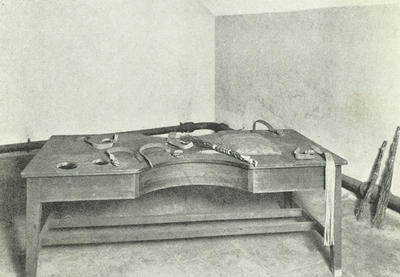
The "whipping table for young delinquents" in the South Prison, in the Justiciary Buildings in Saltmarket, 1909.
Corporal punishment was made illegal in Scotland in 1948. Before then, birching had been a relatively common punishment for boys aged between 8 and 16 for offences such as petty theft, cruelty to animals, vandalism, putting obstacles on railway lines and making hoax calls to the Fire Brigade.
The table is fitted with restraints to hold down the prisoner sentenced to a "birching". There is a birch rod on the table, and two more standing against the wall. The selection of the appropriate rod depended on the age and size of the offender, with the smallest reserved for 8- to 10-year olds and the largest for adults. Boys under 14 years of age could receive a maximum of twelve strokes but those who were aged 14 and 15 could receive a maximum of thirty-six strokes. A doctor's presence was required by law, and he could intervene if the prisoner appeared physically incapable of bearing further punishment.Reference: GC 941.435 OLD
Reproduced with the permission of Glasgow City Council, Libraries Information and Learning
Keywords:
birch rods, birching, corporal punishment, gaols, jails, Justiciary Buildings, juvenile delinquents, prisons, South Prison, whipping tables
You have 0 images in your photo album.